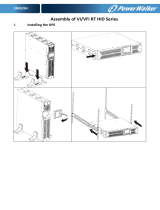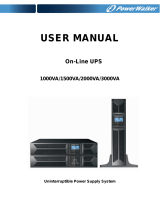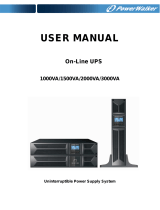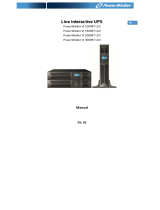
Page 5
8-11kVA EU_EN
ENGLISH
Contents
1. Introduction ....................................................................................... 6
1. 1 Environmental protection ...............................................................................................6
2. Presentation ...................................................................................... 8
2.1 Standard installations .....................................................................................................8
2.2 Rear panels ....................................................................................................................9
2.3 Accessories ................................................................................................................. 10
2.4 Control panel ................................................................................................................ 11
2.5 LCD description ........................................................................................................... 12
2.6 Display functions ......................................................................................................... 13
2.7 User settings ............................................................................................................... 13
3. Installation ...................................................................................... 15
3.1 Inspecting the equipment ...........................................................................................15
3.2 Unpacking the cabinet ................................................................................................. 15
3.3 Checking the accessory kit .......................................................................................... 16
3.4 Connecting the EBM(s) ............................................................................................... 17
3.5 Connecting other accessories .................................................................................... 17
3.6 Tower installation .........................................................................................................18
3.7 Rack installation ........................................................................................................... 19
3.8 Installation requirements .............................................................................................21
3.9 Installation depending on the system earthing arrangement (SEA) .............................22
4. Power cables connection ............................................................... 24
4.1 Access to terminal blocks ............................................................................................24
4.2 Common input sources connection .............................................................................24
4.3 Separate input source connection ...............................................................................25
4.4 Frequency converter connection ..................................................................................25
5. Operation......................................................................................... 26
5.1 UPS startup and shutdown ..........................................................................................26
5.2 Operating modes .........................................................................................................27
5.3 Transferring the UPS between modes .........................................................................27
5.4 Setting High Efciency mode ......................................................................................28
5.5 Conguring Bypass settings ........................................................................................28
5.6 Conguring battery settings ........................................................................................28
5.7 Retrieving the Event log ...............................................................................................29
5.8 Retrieving the Fault log ................................................................................................29
6. Communication .............................................................................. 30
6.1 Communication ports ..................................................................................................30
6.2 Eaton Intelligent Power Software suite .......................................................................33
7. UPS maintenance ............................................................................ 34
7. 1 Equipment care ............................................................................................................34
7. 2 Storing the equipment .................................................................................................34
7. 3 When to replace batteries ...........................................................................................34
7. 4 Replacing batteries ......................................................................................................35
7. 5 Replacing the UPS equipped with a HotSwap MBP ....................................................37
7. 6 Recycling the used equipment ....................................................................................37
8. Troubleshooting .............................................................................. 38
8.1 Typical alarms and faults ..............................................................................................38
8.2 Silencing the alarm ......................................................................................................40
8.3 Service and support .....................................................................................................40
9. Specifications .................................................................................. 41
9.1 Model specications ....................................................................................................41
10. Glossary ......................................................................................... 44
























